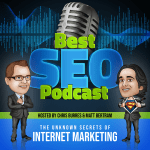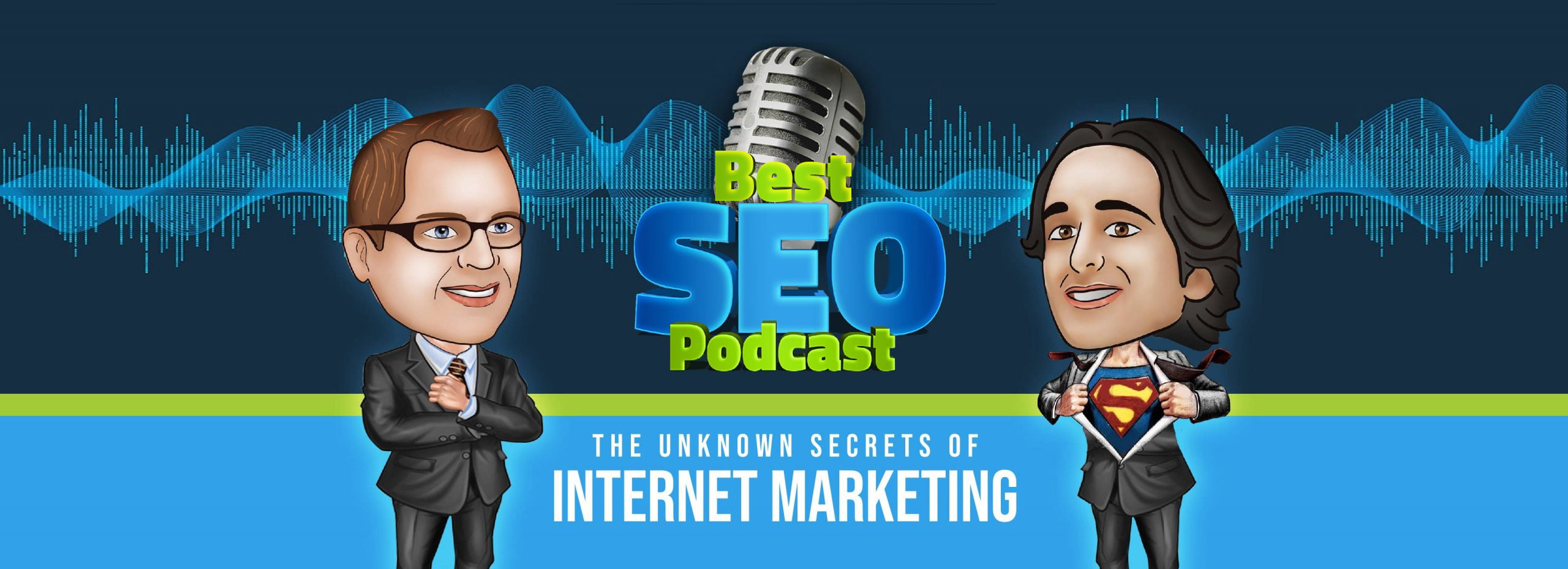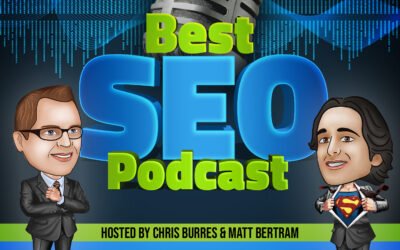

Video Transcript
Chris: Hi and welcome to the SEO Podcast: Unknown Secrets of Internet Marketing. My name is Chris Burres, owner of eWebResults.
Matt: My name is Matt Bertram. The Alabama killers! Whoop!
Chris: The Alabama Killers. So are you guys supposed to win or are you guys not supposed to–?
Matt: Oh no.
Chris: Oh okay. I heard some conversation in our meeting earlier. The side conversation which was, “I’m just hoping we get out like with a couple point deficit.” Welcome to podcast. This is podcast number 390– wait a minute. This is 391, can you take care of that Matt?
Matt: Boom!
Chris: Alright 391. Welcome to another fun-filled edition of our podcast. As always we have a tip from our previous podcast and that tip is–
Matt: Just use YouTube. Use YouTube.
Chris: Use YouTube.
Matt: Use YouTube.
Chris: Out last podcast was on YouTube. And you need to use YouTube because it’s a way to engage your customers and to piggy back off of the tip that we kind of got rid of. Make sure you’re engaging with your customers on YouTube through the entire life cycle of them becoming a customer. So maybe before they’re ready to buy, but they’re trying to gather information. Now they’re interested in buying and narrowing it down, now they actually buy. And then guess what you can use your video to do after they buy? How to use your product. Sounds kind of smart.
Matt: So use YouTube. The same answer said two different ways.
Chris: I think there’s a theme. We definitely have a theme. Alright, so please remember we are broadcasting live here from Houston, Texas. And Matt and I we are your testing and measuring gurus.
Matt: Gurus. I like that.
Chris: Gurus. If you are interested– this is a good podcast. We’re the most popular podcast in the known universe, and have been since the beginning of our podcast. If you like what we’re giving out here, we– you probably want our 17 tips. And you can get our 17 tips by going to eWebResults.com/SEOTips.
Matt: And it’s on the honeymoon.
Chris: Yeah.
Matt: Or the sunset. [00:02:04] [Indiscernible]
Chris: It’s on the sunset. It’s probably gonna get replaced by something else, so if you want some like–
Matt: If you want the tips, they’re good. Get them now. Alright?
Chris: Yeah. We’re not saying our future tips will be bad, I just wanna clarify that. The future tips are gonna continue to be great and better. We’ve got a great article today. We’re actually talking with– we’re actually covering an article by– let me pull this up. Where is it? It’s right here.
Matt: I got it. I got it. Jim Yu.
Chris: His name is Jim Yu and it’s, “14 ways to get smarter with your content and SEO.” So punch in the face to you Jim Yu.
Matt: Appreciate it.
Chris: We’re gonna get into the meat of our podcast here in just a second. As we’re trying to get into the meat– hey, if this is the first time you’ve listened to the podcast: howdy, welcome to the podcast. If you’ve listened to this podcast before, you know what section we’re gonna actually go through. And you also know why I have a– see it? It’s a tear.
Matt: A tear. Okay.
Chris: It’s a tear. Had a get a tear tattoo. See, I get a tear tattoo under my right eye every time we go a week without a review. We did not get a review, so we’re gonna tell you how to help me. So please, help me.
Matt: I mean if we started at 3:30, on time.
Chris: Maybe we get more reviews. It’s definitely a possibility. So there are lots of ways you can leave us a review, and one of them has three steps: go onto iTunes, create an account, write a review. Another place that you can leave us a review is on our Google My Business page. All you need to do– it’s hard to get to. Like if I read the URL, you’d be like, “Okay. This is retarded, stop reading it.” All you have to do is go to eWebResults.com/G+ and that will take you to our search engine optimization page. It actually takes you to a result page of us and you can leave a review right there. So please make that review 5 stars!
Matt: 5 stars! Oh gosh.
Chris: That was–
Matt: That was– yeah.
Chris: The cold came out on that one. Next you can leave us a review on Stitcher. Hopefully they fixed some ailments they had before.
Matt: Gonna have to test that out.
Chris: Just go on to Stitcher. In fact we’ve made it easy for you to get to Stitcher, eWebResults.com/
Matt: Stitcher
Chris: Takes you right there. And finally on Yelp. If you could leave us a review, just go to eWebResults.com/
Matt: Yelp
Chris: Yelp. Yup, that’s it.
Matt: Yelp.
Chris: You’re trying not to say it and there’s really no way around it, right?
Matt: I was like, I didn’t want to yelp.
Chris: Alright. So there are two parts of our contest that we run each and every week. One part is we gotta get a review. We just covered how you can leave us a review, so we can avoid that section next time. The other part is, we have to get 10 shikos. What is a shiko?
Matt: It’s a share, and it’s a like, and it’s a follow. But I think that there should be like a hand signal or like dance.
Chris: Like a shiko signal or a dance? Okay.
Matt: Or like– you know what I mean? Like what if–? Do the shiko. Like doesn’t that sound like something?
Chris: Well we– I like do the shiko.
Matt: Like do the shiko. Do the shiko. Shiko.
Chris: I think you’ve seen me do this. When we get shikos, we actually do the shiko.
Matt: Could you show it? I don’t remember it. Can you do a shiko?
Chris: Absolutely. I can do the shiko.
Matt: Free instructions for the shiko.
Chris: So the shiko’s very much like the safety dance.
Matt: Shiko dance. That’s the shiko dance?
Chris: You can shiko if you want.
Matt: Shiko! Shiko us!
Chris: We gotta shiko. So if you want us to see us do the shiko dance, we just need you to shiko us on our profiles on these platforms. And you can shiko us at– I don’t know. You can shiko us at G+: share, like, and follow. Yeah, you can go to– No you can’t do that.
Matt: You know what would be awesome? If we streamed Twitter feeds.
Chris: Oh that would be cool.
Matt: Like while we were going.
Chris: In the background, I like that. So go onto our profiles. Go to places like Facebook.com/
Matt: eWebResults
Chris: YouTube.com/
Matt: eWebResults
Chris: Instagram.com/
Matt: Not ZeWebResults but eWebResults.
Chris: eWebResults. And LinkedIn.com/Company/
Matt: eWebResults
Chris: And all of those are places you can shiko: share, like, and follow us. Please do that. He’s gonna write the–
Matt: eWebResults
Chris: Next. If you’re a PHP genius or a WordPress guru, go ahead and call, and leave an audio résumé 713-510-7846. If you would like a free– Oh. Oh wait. It’s no longer free. If you would like a comprehensive website profit analysis. Profit analysis. By popular demand, it’s no longer free. We will get one for you. It’s got a $9.99 value. We’re actually giving it away for $4.99.
Matt: That’s pretty awesome.
Chris: Yeah. That’s pretty awesome. And if you get that free profit analysis– why wouldn’t you? Right? You wanna know what’s going on with your website.
Matt: Yes.
Chris: That $4.99 actually applies to any services that you would use us for in the future.
Matt: We’re just giving all kinds of stuff away.
Chris: I’m just giving it away. So you can get that by going to eWebResults.com and then click the — it probably still says free– we’re gonna have to change that. Free website analysis. We’re gonna have to change that.
Matt: On my to-do Monday.
Chris: If you twist our arm, there’s a couple things that could still happen. You might be able to get it.
Matt: And…
Chris: Yeah?
Matt: So a lot of change is happening.
Chris: Yes.
Matt: We’re getting blown up by people. Too many calls. We’re shutting down the phone lines. Are we not?
Chris: We’re gonna shut down the phone lines. Yup. We are, yeah.
Matt: People like Manny, shout out to you. You’re gonna get the special phone number. New inbound calls will go to a prerecorded line. They’ll be able to leave a message. They’ll be able to schedule a 15 minute call. And just letting you know we’re just getting overwhelmed–
Chris: Too inundated, yeah.
Matt: With too many inbound calls, and so we’re gonna have to kind of limit it a little bit.
Chris: Yup.
Matt: We appreciate all the support. We appreciate all y’all out there, and we look forward to working with you. We’re getting a lot of good reports back or testimonials from the consults, yeah.
Chris: I gotta tell you– and I’m not just kissing up to you. Our podcast listeners are our best customers. Like it’s just how it is, right? So they come to us, they know stuff, they’re interested in learning stuff, they can support stuff, they give us like, “Well, what about this?” And we’re like, “Great. That’s the right thing to do. I wouldn’t have thought of it ‘cause I don’t know your industry. I do know internet marketing, that’s the right thing to do. So let’s kick it off.” So yeah, punch in the face.
Matt: Yeah, and I mean that’s kind of a little–
Chris: Yeah.
Matt: So copiloting, right?
Chris: Yeah.
Matt: So really, we’ve had a lot of success in some really challenging industries that we haven’t actually worked in that vertical previously, by copartnering with you and building the content together, and we’re hitting some home runs.
Chris: Yeah. Absolutely.
Matt: Alright? So we really think–
Chris: Literally the client this morning was like, “I just need you to give me more of these.” And like that’s what we’re doing.
Matt: That’s what we do.
Chris: We gave you that one.
Matt: Yeah.
Chris: We’re also trying to give you more of these.
Matt: Yeah. Like everyday, and I was like, “Let’s do it.”
Chris: Boom!
Matt: Yeah.
Chris: Alright so that is– actually I do have one small piece of news and that small piece of news that I found was–
Matt: We don’t have air conditioning here.
Chris: “Amazon is moving to deliver the last mile.” You know right now that last mile– Amazon has warehouses all over the country. They’re using like UPS, they’re using FedEx, they’re about to start a delivery service effectively for their own stuff, where they deliver that last mile.
Matt: Yeah. So could you speak maybe to what you were talking about with Google maybe stopping the emails in 2018?
Chris: So the emails that they’re gonna stop are– so this is related to paid, right?
Matt: Competitor target, is that what it is?
Chris: No, it’s not that. And so I know you were really nervous ‘cause some of the tricks that are up are collective sleeves, you thought were going away. What is going away is: they’re no longer gonna peruse or skim the content of the email, and then allow you to send ads based on the content of the email. That’s about to end. I got confused, I thought it was like they were gonna end some– I said email in general, and I think you almost passed out. Like it was almost happening.
Matt: I’m gonna read that article guys before we get on the next podcast ‘cause there’s definitely some changes. So I looked at some changes with Facebook. Today actually too, there weren’t letting us target different demographics, and different like job titles and schools and stuff. Don’t know what it’s about yet, but I was like, “Okay. If we get rid of that–” there’s a lot of limiting factors going forward. So I don’t know, a lot of changes it seems are happening in the PPC landscape.
Chris: If you notice any changes, send us an email [email protected] – because that’s the only email that it could be – and let us know. Alright we need to jump into–
Matt: Send me an email directly.
Chris: We need to jump right into this podcast– I mean into this content.
Matt: Yes.
Chris: Alright. This again: punch in the face to Jim Yu, “14 ways to get smarter with your content and SEO.” Great article. If you can– I don’t have Jim Yu’s Twitter handle, but you could certainly tweet and mention his name, maybe you can find him. This article was posted at Search Engine Land, and if you’re gonna tweet, go ahead and include us #SEOPodcast, tag us @BestSEOPodcast, @eWebResults.
Matt: @GetSmart
Chris: And so he’s talking about 14 ways to get smarter with your content. I don’t know. Have you heard of SMART Goals? Have you heard of the concept of SMART Goals?
Matt: Yes.
Chris: Alright.
Matt: Ad nauseam.
Chris: So, specific– what is that? Measurable, attainable.
Matt: Realistic.
Chris: Realistic, and time frame. And I don’t think attainable. It wasn’t attainable, it was something else.
Matt: Timely?
Chris: Timely. No, time frame– anyway, so those are SMART Goals.
Matt: I felt like time frame was good.
Chris: Achievable and relevant.
Matt: Tangible, yup. It is tangible.
Chris: Not reasonable but relevant. Anyway, so that’s like what a goal is. So what Jim did is he went through and he said, “Well, let’s make smart goals to make your content and SEO smarter.” I like it. It looks pretty good. So he says, “Content is the vehicle that drives your consumer interactions, your engagements, the experiences and, ultimately, conversions.” Right? So content is your website. Your website is absolutely zero without content, even if you just put up a WordPress template, the images are content. Like that’s content. You wanna do more with that, it’s really important. 41% of marketers think their organization is successfully managing their content marketing. So that’s–
Matt: They self-admit they’re not doing a very good job.
Chris: Yeah. Most of them, right. And then let’s see. “Only 20% of B2C,” Business to Consumer, “and 50% of B2B content earns any engagement at all.”
Matt: This is horrible people.
Chris: Yeah 20%. So think about if you engage somebody in content generation for you. And think about how only 20% of it is actually get engaged with, the rest of it is just– nothing’s happening. Stop generating content and winning zero business, let’s jump into these SMART Goals, right? Does that make sense? And this is gonna be 14 specific ways to make your marketing more effective.
Number 1, “Specific–” this is S from SMART, right? “Specific content wins every time.” So, “Content is not about what your marketing team wants to say. It is about providing insight and information that your audience actually wants to hear.” Right? So that’s the overview of the S.
Point number 1, “Get to know your audience.” We talk about this in the podcast all the time. It’s about targeting who is your audience, how do they communicate. For an example: know where they are in their buying process when you’re speaking to them. So don’t try and sell them when they’re trying to gather information, right? Let them–
Matt: Fish where the fish are.
Chris: Yeah, absolutely. Next. Number 2, “Discover opportunities through topical research.” So the search engine results pages– your competitors may be other companies, but remember on search engine result page, your competitors may be not your competitors. Right? People competing for space, may be just a blogger, right? A brand, an influencer, or more. Make sure you have the bigger picture. Who are you really up against?
Matt: Everybody.
Chris: Everybody. Everybody who wants that position, right? Whether it’s your actual competition or not. Evaluate the content gaps that exist, and then target your content for that.
Matt: So I think what I’m gonna do – because this is the SMART Goals – is I’m gonna let you talk.
Chris: Right.
Matt: And then in like three words or less I’m gonna–
Chris: Summarize it.
Matt: Synopsis.
Chris: You’re gonna be SMART.
Matt: I’m gonna be SMART.
Chris: Alright.
Matt: Yeah.
Chris: Alright. Remember you volunteered for this. Next, “Choose content formats wisely.” Alright? “Don’t limit yourself; a single piece of content–” he said “can incorporate several types of media,” I say should incorporate other types of media. Should we give our trick about media– like content generation that we were kinda brainstorming this morning and talking about how effective it was?
Matt: Sure.
Chris: So what we started doing is getting our customers to actually make short videos of the content that they would like. It’s easier for them to do. Some customers hate video and don’t wanna be on video, but we’re not gonna promote it. We use that video to actually drive the content that we’re gonna make. And if possible, we get them to rework the video so that we can post it live.
Matt: We’re just about making your life easier.
Chris: Yup.
Matt: And so a lot of people it’s way easier to talk than it is to write. And on response times with emails, and bullet points, and lists, like just give it to me right now, we’ll record it, we got it, we’ll get running.
Chris: Remember all the pieces of content you could have, socially shareable images, quick video clips – we just mentioned that – embedded media slide shares, things like that. Alright, so that’s the S part of our SMART, “Specific content wins every time.” Oh now we need the three-word breakdown of “Choose content formats wisely.”
Matt: Choose wisely.
Chris: That’s two words. I’m impressed.
Matt: Content, content.
Chris: That’s like Yoda.
Matt: Yes. I actually was like, “What is a Yoda quote?”
Chris: So next is the M, “Measurable content delivers on the metrics that matter.” Just two years ago, only 20% of B2B – Business to Business – respondents said that they were successfully tracking ROI. Now the number’s like 70% are measuring their ROI, 51% are measuring against their plan to make sure they’re moving towards their goal, and 79% are using Analytics Tools. What we wanna say is: make them measurable. Make your goals measurable and this is what the test and measure gurus have to add.
So number 4 under measurable content delivers, “Choose metrics that matter and align with your business goals.” Right? So measure your content’s performance, talk about lead generation, nurturing. So here’s an example with a client that we were meeting with just today. We’re like, “Well, what are some of the measurable goals?” And he goes, “Well, here’s a measurable goal that I’m going after.” He uses HubSpot so his lead scored all of the people who’ve ever interacted with him. HubSpot’s a pretty awesome platform, so in this particular case he’s using it to actually score the leads that have come in. And he’s looking for the number of high score leads that have filled out a form. Right? That’s that. And make sure that you’re nurturing them through the process, right? Through nurturing, conversion, lead generation retention, and ultimately he calls it evangelism. Yeah, you know what we’re talking about. Like a high-quality customer. What are they called? I went to one convention they called them apostles. You wanna have apostles for your business. So that’s pretty good.
And your summary for, “Choose metrics that matter and align with your business goals?”
Matt: Get some KPIs.
Chris: Get some KPIs, I like it. Number 5, “Make search engine optimization a core component of content creation.” So you wanna apply readability standards, optimize title tags, subheadings, images. This is all SEO 101 stuff, right? Meta descriptions, I decided to highlight meta descriptions. Why are meta descriptions so important, right? When you think about– first off where does the meta description show up, it shows up in the search engine result page, right? It’s the text that’s under the link that gets them to your site. We say that’s the first opportunity for SEVO, Search Engine Visitor Optimization. If you’re leading them, you wanna be one: engaging and enticing. And then you wanna make sure that you’re setting the expectation. That’s the three Es of title descriptions. Engaging, enticing, setting the expectation.
Matt: I like it. Three times fast.
Chris: Engaging, enticing, setting the expectation. I like it. So make sure you’re doing that with your meta description. Some times when we say meta, and often when we say meta people are like– their eyes glaze over and they’re like, “That’s not important anymore.” Your meta description is absolutely important.
Matt: I like that word.
Chris: And make sure you’re using like smart internal linking. So that’s number 5, so what is your synopsis of, “Make search engine optimization a core component of content creation?”
Matt: Make content.
Chris: Make content.
Matt: And tag it.
Chris: Tag it is one word?
Matt: Taggit.
Chris: Alright 6, “Accelerate with automation.” So think about what the most important [00:19:34] [KPI?]– and this is all me, right? Because I don’t want it kind of break off from what he had said. What are the most important [00:19:42] [KTIs?] for your business, and then automate them, right? So we obviously, for each of our clients, we have what’s called an MRC, Monthly Results Call. We review all the data that we’re collecting for our clients and we automate it. So in some of these cases we have to automate it with process, right?
Matt: Yeah.
Chris: Hey, here’s the process. You’re the executive assistant, we need you to pull these reports on a monthly basis and give some sort of abbreviation of that.
Matt: That’s not automation, that’s delegation.
Chris: No, but that’s process.
Matt: Yeah. Yeah, yeah.
Chris: Right? That’s process automation, right? And the other one is system automation, right? So where you can take– get into Google Analytics and actually have automated reports, and we’ve got dashboards. And so there is a lot– a lot of what we do for our clients on a monthly basis come directly from our dashboard.
Matt: That’s how you get more bandwidth, is just building processes and then truly automate it where the computer does it and not a human. You can also outsource it. There’s a lot of different things you can do, but it’s all about time efficiency.
Chris: Yeah, and the more efficient you are, the more time you have to actually focus on what the data is telling you.
Matt: Absolutely.
Chris: And that’s really important. So, your synopsis for, “Accelerate with automation.”
Matt: Be a data scientist.
Chris: Be a data scientist. I like that. I like it. A, alright? So this is part of our SMART Goals. This is from Jim Yu, “14 ways to get smarter with your content and SEO.” A stands for, “Actionable content is always on & ready for activation.” So he’s talking about evergreen content, right? So evergreen content is like, what is the evergreen tree? It’s green throughout the year, it never changes color, drops the leaves, and starts anew. It’s always green.
Matt: Does it grow money?
Chris: It doesn’t grow money. It doesn’t grow it. Now, evergreen content can grow money.
Matt: Whooo!
Chris: Yes.
Matt: Whooo!
Chris: If you do it right.
Matt: Yeah.
Chris: So that’s content that people are interested in time and time again and it’s gonna stay top of mind. So number 7, his point under “Actionable content is always on & ready for activation,” is: “Empower your content creators with technical SEO support.” So yeah. So imagine you’ve got these brilliant content creators and they’re like– you got the most brilliant video guy, you have the most brilliant content writer, and you’ve got the most brilliant description title tag writer, right? And then your pages take 10 seconds to load.
Matt: Oooh.
Chris: It’s not gonna work. It’s just not gonna work, right? So make sure that you get the technical component right. Site structure and hierarchy, meta data, mobile readiness, internal linking, site speed, coding errors. Make sure they’re gone, and make sure you’re not adversely affecting your content’s ability to rank, and make sure that you have the ability to– that your customers, your targets have the ability to find and engage with your content. That’s number 7, “Empower your content creators with technical SEO support.”
Matt: Get textbook on it.
Chris: Get textbook on it. That’s like Pulp Fiction, I like it. Number 8, “Optimize for activation across multiple channels.” Right? So this is number 8, and this is, “14 ways to get smarter with your content and SEO.” So this is push your content to different venues, right? To different channels: Twitter, Facebook. But don’t forget, everyone’s probably doing Twitter and Facebook, hopefully. If you’re not, you need to start immediately. But don’t forget LinkedIn, YouTube, Pinterest, Instagram, G+. Right? So make sure you’re optimizing your social force, but you know– okay. So great, we just gave you a list of platforms and channels you should put it on, but make sure you’re optimizing that content for those platforms, right? You’ve gotta be aware of what you’re posting and where you’re posting.
Matt: So the way that I look at that social is, it’s kind of like a sifter, right?
Chris: Right.
Matt: So make sure you setup all the tags, right? You gotta set up all the tags to play the game properly. But set up all the tags and then move with a couple hundred dollars if you got it. Move it around to the different platforms and see what your message resonates best with, if you don’t know.
Chris: Right.
Matt: Like if you can’t target and go fish where the fish are, you can move that around a little bit and you’ll see where you’re getting traction. Look at your Analytics, you’ll see time on page, you’ll see how many pages they looked at, bounce rate, that sort of thing. And you’ll get it an idea of what platforms respond the best for what clients. And also some of the platforms we talk about that are not as prevalent, it’s not as competitive, right?
Chris: Yeah.
Matt: Like so Bing for example, for Google. Once you got a good campaign, you push it out to Google– oh sorry, you push it out to Bing, and not as much traffic, but highly engaged traffic, cheaper. So you just gotta kinda move it around like– it’s like sand and you’re kind of sifting it and you’ll see what happens. It’s really kinda interesting–
Chris: Process.
Matt: Process with social.
Chris: Says the test and measuring guru. Alright, so what is your summary for, “Optimize for activation across multiple channels?”
Matt: Try something.
Chris: Try something. By the way, your whole little piece right there, I feel like you’ve read the article ahead because this next one really talks about what you just did.
Matt: Yeah?
Chris: Yeah. So the R in SMART is, “Resonate with content promotion in relevant channels,” right? So that’s the whole section. Number 9, “Amplify in social channels for early traction.” So this is again– parallels right with what you’re saying. “Low spend minimums on channels like Twitter and Facebook make it affordable to run experiments.” Another name for experiments is testing and measuring. So what it enables you to do is to figure out who is converting, right? And that’s where you wanna allocate your content promotion budget. So if you’re using Twitter or Facebook and you’re figuring out– and LinkedIn, and you’re figuring out, “Hey, this content is resonating with all of my LinkedIn audience. I have a bigger budget, I just wanted to spend a little bit upfront. Let’s push all of that budget over to LinkedIn and take advantage of that engagement.”
Matt: So one of things I notice in this article, was right here. He’s talking about the initial boost.
Chris: Yes.
Matt: Like where you can kind of juice rankings a little bit and trip some of the algorithms. And this talks about– I think it talks about Facebook and Twitter, but I read on there Google, right?
Chris: Yup.
Matt: Because we’ve seen it, right? We’ve seen it. When you run PP–
Chris: PP tree. The tree you pee on.
Matt: PPC traffic to a website it increases the click-through rate, more visitors, and Google takes that – I believe – and goes, “Hey, this must be more exciting and visible. I’m gonna push it up in the SEO ranking.” So your PPC traffic does actually affect on all platforms your organic traffic.
Chris: And it’s a great way to kind of test and measure. You know if you’re thinking about– hey, one of the things we’re about to mention I think is email. Look number 11 is email. So when you’re thinking about, “Hey, what is the title that’s gonna get the most engagement?” Break it down to three titles. Run three little short PPC campaigns and figure out which one gets the best click-through rate, and boom! You’ve got your email title. I believe that’s a Pro Tip in– yeah.
Matt: Well you put it out on Twitter for free.
Chris: Oh yeah, that too. Which ones get engaged, yeah. That’s a Pro Pro Tip.
Matt: Pro Pro.
Chris: Pro Pro. Not Cray Cray. Alright next. I mean, “Amplify in social channels for early transaction”?
Matt: Yes.
Chris: I like it. Number 10. It’s hot in here. By the way, the AC that wasn’t fixed last Friday is still not fixed.
Matt: It just broke again.
Chris: Yeah.
Matt: It’s a killer.
Chris: 10, “Syndicate and use paid promotion to reach targeted audiences outside of your existing network.” Syndication takes your content and republishes it in other places that you have not been exposed to. Paid syndication services like Outbrain, Taboola, or Zemanta, are ones that you could use. Now–
Matt: Outbrain. I vote Outbrain just FYI.
Chris: Yup. Yup, that’s certainly–
Matt: It’s easier.
Chris: Something we know a little something about. Do it wrong and risk a Google penalty. So don’t risk a Google penalty.
Matt: I actually would like to read this article. I need to read this. This Dan Sullivan, this Dan Sullivan syndicated pieces. I just wanna make sure I’m following the rules.
Chris: So the article– I did read the article. What the article–
Matt: You–?
Chris: Yeah. I read that article. So what the article says–
Matt: I work too hard. Just read too much.
Chris: So what the article says is that if you’re syndicating and it’s legitimate, and you’re getting good content that adds value out there, good. But if you’re just link-building, right? If that’s your whole purpose and you’re syndicating lots of articles that are useless, invaluable, that are written by people who don’t know the subject matter, you will get dinged.
Matt: Oh is that a [00:28:38] [Indiscernible] blog number? Oooh.
Chris: Yeah, yeah. Alright. So what is your summary? “Syndicate and use paid promotion to reach targeted audiences outside your existing network.”
Matt: Use Outbrain.
Chris: Use Outbrain. I like it. “Don’t forget email!” is number 11. It says 86% of people– this is interesting, I had to quote the– I highlight who did the survey ‘cause it’s a little counterintuitive. “86% of people want to receive emails at least monthly from companies they deal with.” Did you know that?
Matt: Yeah. Actually there’s been a lot of data out there statistically that show the more constant contact you provide – like even weekly, even daily – you build that relationship with the individual. And like people– every six months it’s spam. Right?
Chris: Right.
Matt: Like you want to be really tight with your customers. And so you know, I’ve read a ton of data to support more content just is less–
Chris: All I’ve gotta ask is if 86% want to receive that monthly email, why don’t they open it? And that data was from MarketingSherpa survey found in 2015. So your summary for, “Don’t forget email”?
Matt: Put value in email and people will–
Chris: Put value in email and people will– alright. T for “Tangible–” our guru is getting overheated. T for “Tangible business results are derived from SMART content.” These are our last three. Number 12, “Make content profitable with CTAs that drive performance.” Right? What actions would you like the readers to take? And “Don’t forget to include embedded performance tracking for both site traffic and conversions.” We’ve actually kind of split out an entire product line for our company, which is focused on: are you tracking your goals right? So step one, let’s lay that foundation. Do you have the Analytics on there? Do you have the Facebook pixel, the LinkedIn pixel, the Google Analytics, and the goals identified in your Google Analytics? Are all of those things in place? It’s really important to do.
Matt: Absolutely.
Chris: So your summary for, “Make content profitable with CTAs that drive performance.”
Matt: Track it.
Chris: Track it. Number 13, “Incorporate elements that support multiple business functions,” right? So when you have elements of your content that can support– make sure that they support brand authority, that they inspire, that they educate, that they encourage, and that they generate more engagement. Incorporate testimonials into your content. I feel like there’s a mantra around here eWebResults, where’s the testimonial? Right? It’s like– I hear the– do you remember the where’s-the-beef lady? Where’s the Testimonial!
Matt: Well yeah. So I’ve definitely– every website that I see, I wanna have– or landing page, website. Landing page, I wanna see a testimonial.
Chris: Yeah. Document– yeah.
Matt: Because data sells, testimonials sell.
Chris: Yeah.
Chris & Matt: Data tells.
Matt: Testimonials sells. And really don’t hide them away, put them on every page. What other people, third party people sell for you.
Chris: Yup, absolutely. So your summary for, “Incorporate elements that support multiple business functions?”
Matt: Testimonials.
Chris: Testimonials I like it.
Matt: Use them.
Chris: Punch in the face to Nolen Davis for tuning in. Boom! Number 14–
Matt: Boom! It’s hot!
Chris: By the way the video is awesome, and Matt hasn’t seen it yet. “Improve ROI with ongoing content management and optimization,” right? You need to schedule time to visit your popular content. To revisit your popular content. That’s the content that used to be– potentially used to be real popular and it’s maybe less popular. So how do you need to tweak it to make it evergreen? Or that content that is popular and it’s still popular, maybe you need to be updating it, because eventually it won’t be popular.
Matt: Well, I mean look, every client we talk to they’re like, “Hey, I was ranked on the first page of Google, now I’ve fallen off.” “I was in the three-pack earlier today. I’ve fallen out, like what do I need to do?” And everybody wishes the internet was static. Trust us, we do too, but it’s constantly moving, it’s organic, it’s changing, and you gotta keep doing things to stay competitive. And listening to this podcast is step one, talking to us is step two, take action and call us is step three, and then use our products, step four. And this is a very CTA.
Chris: Yeah, that’s a CTA.
Matt: That’s a CTA.
Chris: Call to action. What was the actual action you wanted them to take?
Matt: Start the process and we’ll nurture you as you need.
Chris: Fill out the form on the website, eWebResults.com.
Matt: Yes, boom.
Chris: Alright and to wrap this all up, “SMART content is always on, always optimized, and – most importantly – profitable.” Jim Yu, punch in the face to you Mr. Yu.
Matt: Shiko. Shiko. Shiko dance.
Chris: We really– the shiko dance. We can shiko if you want to. Alright–
Matt: Shiko if you want to.
Chris: Alright. Alright, we’re gonna give a punch in the face to [00:33:46] [Karima] is that right? Punch in the face to you [00:33:50] [Karima] She–
Matt: For calling in!
Chris: We just spoke with her on the phone. Great conversation, hopefully you got great value– well, I know you got great value out of it. We’ll be seeing more of you. Alright. Let’s see. So to wrap this up. Hey, if you would like to get–
Matt: Air conditioning.
Chris: To grow your business– to grow your business with the largest, simplest marketing tool on the planet.
Matt: The internet.
Chris: Then give us a call for increased revenue in your business 713-592-6724. If you have a referral – somebody who’s interested in any aspect of internet marketing – send them to us. When they pay their bill, we will pay you. We have that referral program in place.
Matt: And we’re gonna blow it up. We’re gonna blow that up.
Chris: If you’re doing networking, business networking in Houston, go to UPSocialNetwork.com, next event is Tuesday. So join us. Please remember we were filmed live here at 5999, West 34th Street, Suite 106– I know I missed– did I miss something? 106, Houston, Texas, 77092.
Matt: We’re live.
Chris: We are live. If you would like a video, audio, or a transcript of this podcast, you can get it on our podcast eWebResults.com. And then I feel like there’s one other thing that we should do, but I don’t know what it is.
Matt: Let’s do something special. I don’t know, I feel like yeah, we need something.
Chris: In unison?
Matt: What do we need? What do we need?
Chris: We’re gonna do the shiko dance.
Matt: We’re gonna start the shiko dance.
Chris: The shiko dance should have another letter, like SMCA.
Matt: Why were you–? What is it? Shi?
Chris: Share, like, and follow.
Matt: Li? Fo?
Chris: Share, like, and follow.
Matt: It’s like the new YMCA.
Chris: Alright, you guys have made us the most popular internet marketing podcast on iTunes. This is probably the only video that you really, really needed to watch, ‘cause there was shiko dancing. Thank you for making us the most popular internet marketing podcast on iTunes. It is because of you. Go ahead and contact with us, engage with us, shiko us, send us an email Podcast@
Matt: eWebResults
Chris: .com and we’ll have conversations with you live and in our podcast. Until the next podcast, my name is Chris Burres.
Matt: Matt Bertram.
Chris: Bye bye for now.
Related Episodes
Episode-567-12-proven-local-seo-tips-to-dominate-the-serps-and-map-pack-2
Follow Us On Youtube Chris Burres ·00:16 Hi and welcome to the SEO podcast. Unknown secrets of internet marketing. My name is Chris Burris. Matt Bertram ·00:22 And my name is Matt Bertram. Chris Burres ·00:25 Welcome to another fun-filled edition...
Episode 566: How To Conduct A Content Audit Step-By-Step (Part 2)
Follow Us On Youtube Chris Burres ·00:16 Hi and welcome to the SEO podcast. Unknown secrets of internet marketing. My name is Chris Burris. Matt Bertram ·00:22 And my name is Matt Bertram. Chris Burres ·00:25 Welcome to another fun-filled edition...
Episode 565: How To Conduct A Content Audit Step – By – Step.
Follow Us On Youtube Chris Burres ·00:16 Hi and welcome to the SEO podcast. Unknown secrets of internet marketing. My name is Chris Burris. Matt Bertram ·00:22 And my name is Matt Bertram. Chris Burres ·00:25 Welcome to another fun-filled edition...
Enjoying This Episode?




